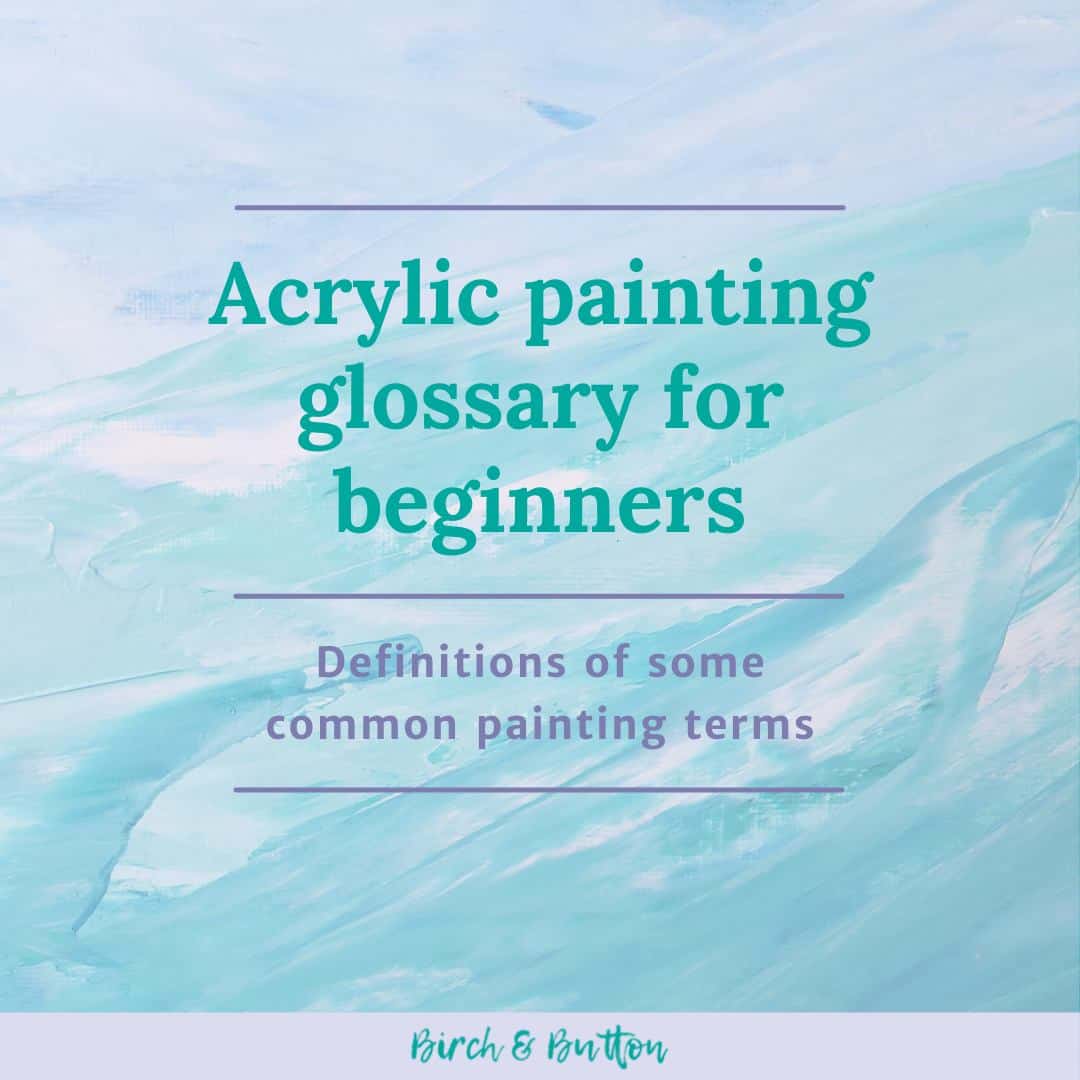If you’re just starting out with acrylic painting and you’re confused by some of the words and phrases used when talking about it, let me help you out. Read on for my glossary of some common acrylic painting terms.
When I first started acrylic painting, I felt like I’d just visited another country where I didn’t speak the language. There’s a pretty steep learning curve at the beginning, and it can be overwhelming and bewildering to say the least!
With this in mind, I’ve put together a handy glossary of some terms commonly used in acrylic painting.
Sign up for my monthly emails of creative tips, tutorials and DIYs and get 31 free creative prompts!

You can unsubscribe at any time
Firstly, what actually IS acrylic paint?
Acrylics are a kind of synthetic paint. In the same way that oil paints are made from pigments suspended in an oil (typically linseed), acrylic paints are made from pigments in a liquid acrylic resin.
Acrylic paints are water-soluble when wet, but dry to become water-resistant. They’re very versatile as they can actually be used like watercolours or oils, depending on the effect you are trying to achieve.
Glossary of acrylic painting terms for beginners
Acrylic ink
Acrylic ink is a form of acrylic paint with the fluidity of water but the same permanence as any other kind of acrylic paint. It’s generally sold in bottles with a dropper.
Artist grade paint
Also known as professional grade paint. This is the best quality paint with the highest amount of pigment. Consequently, it’s the most expensive.
Binder
The binder is one of the main ingredients of paint, alongside the pigment. It’s what holds the paint together.
Complementary colours
Complementary colours are opposite each other on the colour wheel (see the image below).
Examples of pairs of complementary colours include red and green, orange and blue, and yellow and purple.

Craft paint
This is the cheapest kind of acrylic paint and contains the least pigment. It’s available in a huge range of colours.
Fluid paint
Also known as soft body paint. As the name suggests, this paint has a more fluid texture than heavy body.
Fluid acrylics tend to level out on the painting surface, meaning they don’t hold brush strokes or texture.
Gesso
Gesso is a gritty substance. When it’s painted onto canvases or other surfaces, it helps the acrylic paint stick. White gesso is most common, but black and clear are also available.
Ground
Also known as the primer. The ground prepares the surface for painting on. Gesso is a ground.
Heavy body paint
Heavy body paint has a thicker texture than fluid paint, and is spreadable like soft butter. It often comes in tubes (or in tubs in larger quantities).
Hue
A hue is a pure colour, like those you would find on a colour wheel. (See the colour wheel image above.)
Impasto
Impasto is a technique commonly associated with oil painting. It involves applying paint thickly, often with a palette knife, so lots of texture remains.
Medium
This is an additive that’s mixed into acrylic paint to achieve a certain outcome, such as making the paint dry more slowly or look glossier.
Opacity
If something is opaque, it isn’t see-through. The higher the opacity of the paint, the less you’ll be able to see through it to what’s behind (ie the canvas or another colour).
Open time
The open time is how long the paint remains wet on the canvas. This isn’t very long for acrylic paint.
To blend colours together you need to either work quickly or use a medium to slow the drying time.
Palette
A palette is a flat surface used to hold your paint ready for painting. This might be plastic, treated wood, or even a piece of wax paper!
Stay-wet palettes are really useful when working with acrylics, as they hold a piece of damp paper that stops the paint drying so quickly.
Palette knife
A palette knife is a tool used to mix paint or apply it to the surface you’re painting on. It’s great for creating texture with thick paint and mark making, but it’s not the best tool for painting delicate details.
The ‘blade’ of the knife is usually flexible. Despite the name, a palette knife is blunt and can’t be used to cut!
See also: Impasto
Permanence
This is how well the paint holds up over time to fading and colour-shift. The higher the permanence rating, the better a paint should last.
Pigment
This is the substance in paint that gives it its colour. Some paints cost more because the pigment is an expensive material. Better quality paints are usually more expensive because they contain more pigment.
Primary colour
There are three primary colours: red, yellow and blue. You can use these to mix all other colours.
However you can’t mix pure red, yellow, or blue from other colours.
Primer
Also known as the ground. The primer prepares the surface for painting on. Gesso is a primer.
Professional grade paint
Also known as artist grade paint. This is the best quality paint with the highest amount of pigment. Consequently it’s also the most expensive.
Secondary colours
There are three secondary colours. To make them, mix the primary colours as follows:
- yellow + blue = green
- red + yellow = orange
- blue + red = purple
Soft body paint
Also known as fluid paint. As the name suggests, this paint has a softer texture than heavy body.
Soft body acrylics tend to level out on the surface, meaning they don’t hold brush strokes or texture.
Shade
To make a shade, add black to a colour.
Student grade paint
These paints are ideal for experimenting with as a hobbyist. Although they have less pigment than artist grade paints, you can still achieve good colour mixes and make great paintings.
Tertiary colours
To make the six tertiary colours, mix a primary colour and its nearest secondary colour. They are as follows:
- yellow + green = yellow-green
- yellow + orange = yellow-orange
- red + orange = red-orange
- red + purple = red-purple
- blue + purple = blue-purple
- blue + green = blue-green
Tint
To make a tint, add white to a colour.
Tone
To make a tone, add grey to a colour (so you’re adding black and white).
Tooth
This is the texture of the painting surface. If you look closely at a canvas, you can see it has quite a rough texture. This helps the paint stick to the surface. You can give a smooth surface some tooth (teeth?!) by painting it with gesso.
Transparency
If something is transparent, it’s see-through. The higher the transparency of the paint, the more you’ll be able to see through it to what’s behind (ie the canvas or another colour).
Underpainting
Acrylic paintings are generally made up of layers. The underpainting is an initial layer of paint that is intended to be painted over. (Like underwear on a person, you can’t see the underpainting but it definitely serves a purpose!)
Wash
This is thinned-down paint used to cover a large surface.
Leave a comment below if there’s anything here that doesn’t make sense to you. I’d also love to know if there are any other terms you think I should add to this glossary of acrylic painting terms!
About Stacey

I’m Stacey and I’m a blogger, abstract artist and freelance writer. My aim is to help busy people feel inspired and get more creative with tutorials, hints and tips.
I live in Cardiff with my partner and dog, and in my free time you’ll find me hiking, reading, painting or sampling a craft beer or two.

